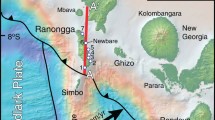Abstract
The longest records of earthquake activity1 may be preserved near the edges of carbonate platforms where reefs have bordered active faults. Because the carbonate sediments build up almost to low tide level, because their character and lithification are very sensitive to deviations from that datum, and because they commonly lithify soon after deposition2, strata can precisely record changes in lithospheric flexure3, which in turn record the buildup and release of elastic strain energy during stick–slip faulting. The approximate stratigraphy is predictable for a given history of faulting. Comparison of predictions with observations leads to an explanation for some of the hemicyclic sedimentary sequences common4–6 on carbonate platforms. These records are important for characterizing the seismicity of Atlantic-type continental margins in general. After rifting, faults evidently remain active7, but major earthquakes are so rare that their recurrence times cannot be established from direct observations.
Similar content being viewed by others
References
Sieh, K. E. in Maurice Ewing Series Vol. 4 (eds Simpson, D. W. & Richards, P. G.) 181–207 (American Geophysical Union, Washington, 1981).
Bathurst, R. G. C. Carbonate Sediments and Their Diagenesis (Elsevier, Amsterdam, 1975).
Cisne, J. L. J. Geol. 93, 567–576 (1985).
Wilson, J. L. Carbonate Fades in Geologic History (Springer, New York, 1975).
Enos, P. Mem. Am. Ass. petrol. Geol. 33, 267–343 (1983).
James, N. P. in Facies Models 2nd edn (ed. Walker, R. G.) 213–228 (Geological Association of Canada, 1984).
Turcotte, D. L., Ahern, J. L. & Bird, J. M. Tectonophysics 42, 1–28 (1977).
Kendall, C. G. St. C. & Schlager, W. Mar. Geol. 44, 181–212.
Mavko, G. M. A. Rev. Earth planet. Sci. 9, 81–111 (1981).
Scholle, P. A., Bebout, D. G. & Moore, C. H. Mem. Am. Ass. petrol. Geol. 33, 1–708 (1983).
Bosellini, A. & Rossi, D. Soc. Econ. Paleontol. Miner, spec. Publ. 18, 209–233 (1974).
Braun, M. & Friedman, G. M. J. sedim. Petrol. 39, 113–135 (1969).
Hoffman, P. F. Phil. Trans. R. Soc. A273, 547–581 (1973).
Hoffman, P. F. Geol. Ass. Can. spec. Pap. 20, 523–549 (1980).
Harland, W. B. et al. A Geologic Time Scale (Cambridge University Press, 1982).
Zankl, H. Geol. Rdsch. 56, 128–139 (1967).
Zankl, H. in Sedimentology of Parts of Central Europe (ed. Muller, G.) 147–185 (Kramer, Frankfurt, 1971).
Fischer, A. G. Kans. geol. Surv. Bull. 169, 107–149 (1964).
Fischer, A. G. in Tidal Deposits (ed. Ginsburg, R. N.) 235–242> (Springer, New York, 1975).
Vail, P. R., Mitchum, R. M., Jr & Thompson, S. III Mem. Am. Ass. petrol. Geol. 26, 83–97 (1977).
Wallace, R. E. in Maurice Ewing Series Vol.4 (eds Simpson, D. W. & Richards, P. G.) 209–216 (American Geophysical Union, Washington, 1981).
Author information
Authors and Affiliations
Rights and permissions
About this article
Cite this article
Cisne, J. Earthquakes recorded stratigraphically on carbonate platforms. Nature 323, 320–322 (1986). https://doi.org/10.1038/323320a0
Received:
Accepted:
Issue Date:
DOI: https://doi.org/10.1038/323320a0
- Springer Nature Limited
This article is cited by
-
The implications of structural control on the miocene carbonate reservoirs of Bakr-Al Hamd oil fields, Gulf of Suez
Journal of Petroleum Exploration and Production Technology (2024)
-
High-energy events in the Frasnian–Famennian boundary interval of the Płucki section in the Holy Cross Mountains, Poland
Facies (2020)
-
Depositional facies and cyclic patterns in a subtidal-dominated ramp during the Early-Middle Ordovician in the western Tarim Basin (NW China)
Facies (2018)
-
Depositional facies and stratal cyclicity of dolomites in the Lower Qiulitag Group (Upper Cambrian) in northwestern Tarim Basin, NW China
Facies (2015)
-
Lithostratigraphy, sedimentology, and cyclicity of the Duwi Formation (late Cretaceous) at Abu Tartur plateau, Western Desert of Egypt: evidences for reworking and redeposition
Arabian Journal of Geosciences (2015)





